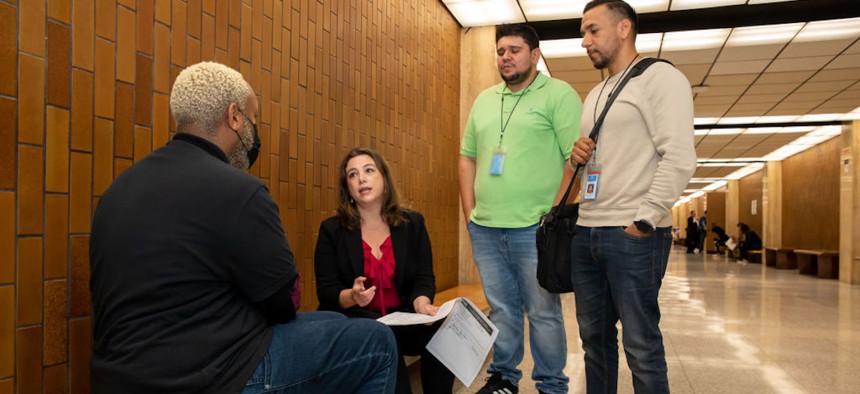How one public defender’s office is embracing tech to better serve its clients

Public defenders in Los Angeles are getting help in their efforts to provide better representation for clients in the form of AI and other technology. Irfan Khan / Los Angeles Times via Getty Images
The Los Angeles County Public Defender’s Office has digitized many records and is looking to use artificial intelligence and automation in a bid to provide an effective defense.
Representing 140,000 clients a year means a tremendous amount of legwork and paperwork for the 1,000 attorneys and 5,000 support staff at the Los Angeles County Public Defender’s Office.
But over a century after its founding as the first such agency in the United States, LACPD is moving into a new future thanks to a push to digitize documents and rely more on automation and artificial intelligence. The office is looking to utilize technology to make work more efficient for staff and to provide better representation for clients, who cannot reasonably afford a lawyer to defend them at trial.
The push began in 2018 when the Los Angeles County Board of Supervisors appointed Ricardo Garcia as the county’s public defender. One of Garcia’s first acts on the job was to appoint a chief information officer, Mohammed Al Rawi—the first to hold the position in the agency’s history. Garcia wanted to tap technology to ensure his office was serving clients effectively.
In an era when most public defender’s offices are underfunded, understaffed and overwhelmed with caseloads, Garcia wanted to lean on tech to bring better outcomes for defendants and make the office more people-centric than case-centric.
“Cost savings, efficiencies, reducing paper, to me, is an excellent side effect,” Al Rawi said of the effort. “But it's not the driver. What we're doing here is keeping families together, preserving the Sixth Amendment, protecting the presumption of innocence, holding all justice agencies accountable and providing the best client representation for the residents of Los Angeles.”
The agency’s 2020 strategic plan set a goal of adopting “leading edge and innovative technologies that make information and advanced data analytics digitally readily available.”
It hasn’t been an easy task, however. According to Al Rawi, the agency operates using 23 legacy systems, some of which date as far back as the 1960s and rely on COBOL, a 64-year-old programming language. And with 99 law enforcement agencies to receive client and casework from, the paperwork can quickly pile up in what Al Rawi dubbed several “iron mountains” in satellite offices across the county.
But those mountains are toppling. A major part of the modernization process has been the implementation of a client case management system that runs on the cloud. Documents from cases going back 20 years have been fully digitized under an effort Al Rawi calls “undoing a century worth of paper accumulation.” Adult cases went live in this digital form in late 2020, followed by juvenile cases last year.
Machine learning and artificial intelligence helps attorneys more easily sort pages and extract useful information in a client’s defense. Previously, LACPD had considered hiring more data entry staff to help digitize documents and extract information, but that was deemed too costly and time-consuming.
With digitized documents and a cloud-based client case management system, attorneys can now receive automatic notifications when documents, filings or judicial rulings are added to cases. And in the instance of accidental parole violations, which can result in a client being sent to jail if they forget to check in with their parole officer, it can prevent that worse-case scenario for defendants.
The public defender’s office is also using AI in client representation. The technology helps to transcribe audio from footage captured by body-worn police cameras, CCTV or calls to 911 as part of the evidence gathering process. And generative AI could soon help draft memos, motions, reports and other filings necessary for court.
“The result is like building a giant Lego,” Al Rawi said of the office’s modernization effort. “It's so complex and so difficult, but then when you take a step back…. This is what makes it all worth it—when I have attorneys come to my office with their clients who have been completely exonerated.”
It is unclear whether other public defender’s offices have adopted similar digitization efforts. The National Association for Public Defense, which represents public defender’s offices, did not respond to requests for comment. But Al Rawi acknowledges that LACPD has an advantage over many public defender offices in that it is well funded.
If other agencies want to go on what Al Rawi calls a “complex and long marathon” towards a more technological approach to criminal defense, however, humanizing its impacts is crucial in convincing governments to appropriate money for the effort.
“Once you can start to show the value qualitatively and quantitatively is when you can move mountains and improve and empower your operations,” Al Rawi said. “That is key: telling people's story and humanizing a business process that has not been human centered for centuries.”






